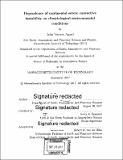Dependence of continental severe convective instability on climatological environmental conditions
Author(s)
Agard, John Vincent
DownloadFull printable version (12.74Mb)
Other Contributors
Massachusetts Institute of Technology. Department of Earth, Atmospheric, and Planetary Sciences.
Advisor
Kerry A. Emanuel.
Terms of use
Metadata
Show full item recordAbstract
Most of Earth's strongest atmospheric convection occurs over the continents, where potential energy is stored over time in metastable vertical profiles, only to be released rapidly by severe storms. In contrast to equilibrium-state convection in tropical ocean regions, there is a relative paucity of research exploring the climate dynamics of continental deep convection. This work makes a contribution to rectifying that deficiency by exploring the physical mechanisms by which convective available potential energy (CAPE) is generated, and their dependence on climatological properties of the Earth's environment. First, a budget of the time tendency of CAPE is used to examine the buildup of CAPE in advance of severe convective storm events in North America via case studies using reanalysis data. Contributions to extreme peak CAPE from relative advection of air masses, diabatic heating of the surface boundary layer, and radiative cooling of the free troposphere are computed. In all 8 cases studied, CAPE buildup is found to be driven primarily by fluxes of heat and moisture from the surface into the boundary layer on sub-diurnal time scales, and not by radiative cooling or the relative advection of air masses at low and upper levels over multiple days. This result is then further explored using an idealized two-dimensional continental framework using a minimal numerical model. Experiments in both 2-column and 40- column configurations demonstrate a link between discontinuities in surface moisture and high levels of transient CAPE. Surface entropy flux is once again found to be the primary driver of peak CAPE buildup within the model. Finally, a thermodynamic constraint on CAPE in continental environments is established using an idealized, one-dimensional model. This theoretical model incorporates the physical principle of CAPE generation identified using reanalysis and two-dimensional modeling by considering a dry adiabatic column that comes into contact with a moist land surface. A system of equations is derived to describe the evolution of the ensuing surface boundary layer. From these, the maximum value of transient CAPE in the column can be found for any particular combination of surface temperature and moisture. It is demonstrated that, for a given range of surface temperatures, the value of peak CAPE scales with the Clausius-Clapeyron relation.
Description
Thesis: Ph. D. in Atmospheric Science, Massachusetts Institute of Technology, Department of Earth, Atmospheric, and Planetary Sciences, 2017. Cataloged from PDF version of thesis. Includes bibliographical references (pages 115-119).
Date issued
2017Department
Massachusetts Institute of Technology. Department of Earth, Atmospheric, and Planetary SciencesPublisher
Massachusetts Institute of Technology
Keywords
Earth, Atmospheric, and Planetary Sciences.